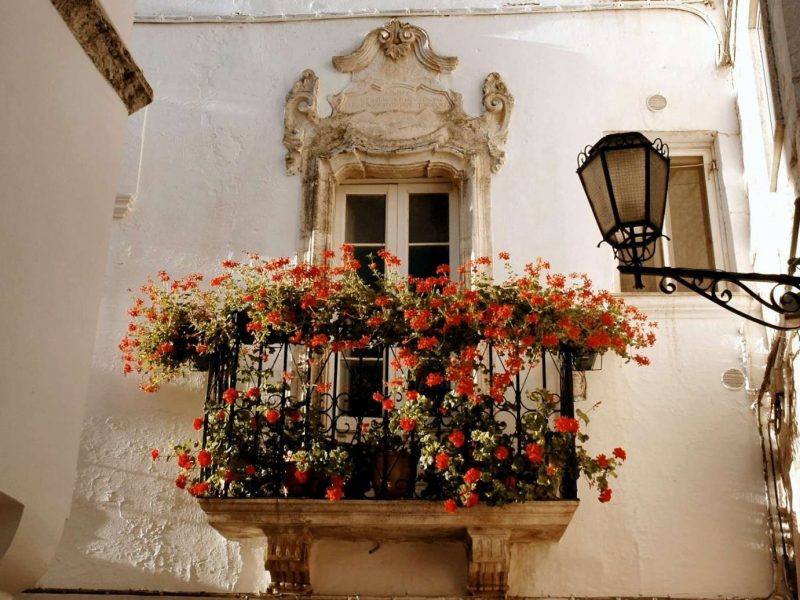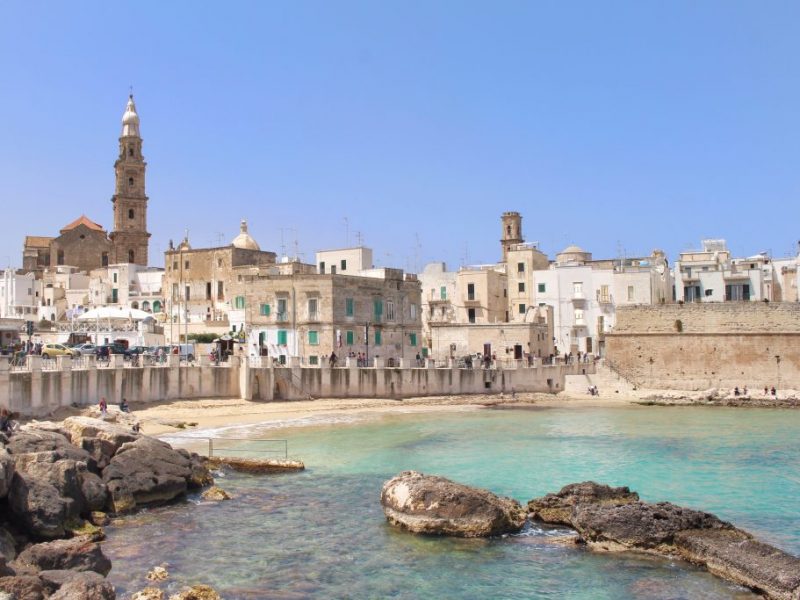The Borgo of Polignano a Mare
“This place was created before Paradise.”
The eternal wisdom of the waves: day after day, persistently crashing against the rocks, knowing that slowly but surely the hard stone will be rendered smooth and molded by their impervious will. The waves of Polignano a Mare must be grand maestros: they have embroidered the high cliffs, designed exquisite inlets and carved magical caves, all of such indescribable beauty that words have not yet been invented for such marvels.
It would be no surprise if mermaids existed in Polignano a Mare, where the sea is “Il blu dipinto di blu”*, a clear and brilliant blue you can find nowhere else but here, in this ancient borgo with a delicate soul. The houses seem to want to protect themselves from the incoming tide, rising in a wall to unite against the force of the waves. But the refreshing scent of the salty breeze gets through and caresses the little stone streets, lingering on the tourists as they return from their swim, climbing the stone steps to the little restaurants serving fresh grilled fish. The salt-air blends with the pungent herbs of the Mediterranean foliage and the mint of the “Mojito women”, the elderly ladies who sit on their stoops and prepare the principal ingredient for the favorite cocktail of the festive nightlife.
Along the streets of the historical center, a sweet wind of poetry blows, leaving its traces on the doors, the windows and the stairways. Poems are everywhere, in delicate black letters, recounting thoughts and stories that illuminate the soul and make every day in this little borgo a gift: on the days when happiness is so great that it overflows and must be shared, but also on the days when the dark, swirling tide of melancholy takes its toll. Even if the high winds rage and a threatening storm looms on the horizon, Polignano is always a treasure chest of deep emotions. Standing on the high cliffs, gazing out at the dark horizon, a flash of lightning dazzles the black sky, and it is suddenly magic, and suddenly you want to fly, spreading out your arms in the wind, your jacket blowing behind you like Domenico Modugno, the marvelous Italian singer who wrote “Volare”, immortalized here in the bronze statue that stands facing the waves, his arms flung wide, eternally challenging and embracing the sea.




































History
The origins of Polignano a Mare continue to incite contrasting hypotheses. We are sure that this territory has been inhabited since Prehistoric times, but as far as the foundation and the name of the borgo, nothing is certain. The most accredited hypothesis is that Polignano was founded by Julius Caesar himself, who concentrated his attention on this location because of its key position on the road from Rome to Brindisi, an important Mediterranean port, and thus highly strategic economically. Later, with the arrival of Greek colonies in southern Italy, Polignano assumed a well-organized urban structure and adopted the Greek Orthodox religion, as a result of the influence Orthodox monks migrating from the east. The history of this borgo is a tapestry of continually increasing beauty and wealth: every denomination that reigned over the city through ages brought something beautiful and valuable, and it is this combination of influences which today characterizes the city. The Normans, the Aragon dynasty, and even the Venetians at one time made Polignano their home.
On August 5, 1862, an official document authorized the city with the denomination “Polignano a Mare”.
Over the centuries, this tiny borgo has captured the attention of emperors and royalty, as well as national and international figures of historical and cultural importance, and still today continues to delight and enchant the many visitors who come each year.
Sea Caves, Ravines and Inlets
The crystalline waters of Polignano a Mare find protection in the many sea caves along the coast.
Carved by the wind and the persistence of the waves, the breathtaking sea caves of Polignano will leave you speechless with awe, dizzied by the play of light on the water, as rays of light cut through the brilliant blue of the silky depths and reflect off the walls that seem carved by master sculptors.
From Via Narciso, crossing a little bridge, you will reach the “Grotta Palazzese” the most famous of Polignano a Mare’s sea caves, known for its marvelous little restaurant inside the cave, where you can dine suspended over the sea, classified as one of the most beautiful sea-side restaurants in the world.
Local guided boat tours can take you to visit all the other sea caves sculpted into the ravines. Your little craft will take you to explore Grotta Ardito, Grotta delle Rondinelle, and Grotta dell’Arcivescovado, to name only a few.
But the sea of Polignano is not only to be seen! How can you resist a delicious swim in its crystal clear blue waters? There are many wonderful little sandy bays, called “Calas” to choose from. You can reach the white beach of Cala Porto directly from the historical center, or you can discover the sublime bay of Cala Fetente or the enchanting golden sands of Cala Paura, where the bright colors of the fishing boats dance above the brilliant blue of the sea.
The Abbey of San Vito
A little village was built around the Abbey of San Vito, which today is a hamlet of Polignano a Mare. It is an oasis of peace and tranquility, and its beauty has made it a favorite touristic stop. Directly on the sea, it was built in 1063 by the Benedictine monks, set in the natural bay of San Vito. The Abbey was remodeled many times, encountering the Baroque influence along the way, but nonetheless it has conserved its aspect of monastic austerity. A museum inside the monastery displays twelve paintings of the Apostles, while in the church you can find a magnificent triptych of San Vito, San Modesto and Santa Crescenzia. Legend has it that in 801 A.D. the relics of the three saints reached these shores and that they were placed in the care of the Benedictine monks.
Today, the Abbey and the ancient complex of houses around it are privately owned by the Tavassi-La Greca family.
Polignano a Mare and the multicolored carrots
The magical sea caves and the breathtaking cliffs capture the fascinated gaze of Polignano’s visitors, but it’s only fair to say that inland territory is every bit as beautiful, especially when you explore the rustic farmlands that are the heritage of the agricultural life of the borgo. The countryside south of Bari is not only full olive groves, it is also a thriving paradise of various crops and beautiful masserias (ancient fortified stone farm complexes), protected by low, ancient stone walls.
In the area between Polignano a Mare and the hamlet of San Vito, a small miracle occurs, fruit of the collaboration between nature and the wisdom of man. Every year, in this tiny handkerchief of land, a variety of carrot is grown that exists only in Polignano. It is a multicolored carrot, with shades of pale yellow that gradate to orange and then precipitate to a vibrant purple.
The meticulous care of this crop begins even before it touches the earth: the farmers choose the very best plants from the previous year for the seeds to plant the new crop, which is planted between the 15th of August and the 15th of September. The carrots are planted in a terrain of ten acres, in earth with an elevated saline content. They are watered with brackish water drawn from a well that was constructed in 1800, which is in communication with infiltrations of sea water and is subject to the influence of the high and low tides. The most difficult phase of the work is the harvest. A small fork-like tool loosens the earth and the plant is extracted with care and separated from the carrot, which is then placed in a tub of salty water and gently moved by tiny delicate motors until it is thoroughly cleaned. The result of this process is a delicious carrot with a completely unique taste: fresh, and slightly salty, which can be bought at the local market. To protect this priceless example of Polignano’s agricultural heritage, this species of carrot has been included in the Presidio of Slow Food, which has the task of safeguarding high quality food, fruit of the artisan farmers’ passion for authentic quality and the inestimable value of ancient traditions.
“Io che amo solo te” (I Love Only You)
Polignano a Mare can also be discovered between the lines of various novels, two of which are Luca Bianchini’s “La cena di Natale” (The Christmas Dinner) and “Io che amo solo te”, set in a Polignano caressed by the Maestrale breeze. The story centers on two families: that of Ninella and the family of Don Mimì, an important business owner in Polignano, known to everyone as the “Potato King”. The novel begins on the day before their children are to marry each other, but the true protagonists are the parents of the bride and groom, who have been silently and secretly in love with each other since their youth. Even though unfortunate circumstances separated them long ago, neither of them has been able to forget their first love.
All the hypnotic beauty of Polignano can be found in the pages of this novel, agitated by wedding preparations and delightfully colored with by the facets of life typical to a village in southern Italy.
Domenico Modugno
Mimì Urzzill: the old folks of the town still remember him that way, the curly haired boy as humble as he was ambitious, whose true name was Domenico Modugno. He was born in 1928 in Polignano a Mare, which he soon left for the more industrialized Turin in search of fame and fortune. He came home and left again, always keeping his head down, always taking humble means of employment as he waited for his first big chance. It came in 1951, when Eduardo de Filippo gave him a small role in the film “Filumena Marturano”. In 1953, he began to work in radio, participating in the contest “Il Trampolino” which led him to conduct important radio transmissions which he both wrote and directed. All during this time he never stopped singing and writing songs, in fact, these were the years when songs in dialect from Puglia and Sicily had become widely popular. In 1957, he won the “Festival della Canzone Napoletana”, which brought him the popular success he had been striving to achieve, opening the door to a career of widely acclaimed international fame.
The next year, in 1958, Domenico Modugno reached the high point in his life. He sang the winning song at the Festival of Sanremo: “Il blu dipinto di blu”, written by himself and Franco Migliacci, which everyone knows as “Volare”, and which became the unofficial Italian anthem, a widely popular hit that set off the economic boom of the Italian recording industry. Modugno performed on stages all around the world: in America he was awarded the Oscar of music: his “Il blue dipinto di blu” was the first song to win a Grammy Award, both as best album and best song.
In 1959 and in 1960 he participated again in the Festival of San Remo and won both times, with “Piove” and “Libero”. In addition to his international success as a singer/songwriter, he continued in his brilliant career as an actor, and was acclaimed in numerous important theatrical works. At the same time, he also continued to write plays, such as “Tu si na cosa grande pe’me” for which he won first prize at the Festival of Napoli.
His last years were dedicated to political activity, conducted with the same vibrant passion that had always characterized his artistic achievements. First, he became a member of the Italian Socialist Party, and then joined the Radical Party. He was seriously ill twice during this period, after which his health continued to decline. His last artistic effort was the song “Delphini” (Dolphins), recorded with his son Massimo in 1993, the same year he left this earth, passing away in his house overlooking the sea on the island of Lampedusa, Sicily.
In Polignano, Domenico Modugno is in the air that you breath, in the blue of the sea, the homeland that he both loved and hated, as he sang with heartfelt honesty in “Amara terra mia” (My bitter homeland).
Polignano has always adored him, and to keep him close to home, in 2009, a statue was dedicated to him in bronze, created by the Argentine sculptor Herman Mejer. His arms are flung open wide in the same exuberant gesture he always made before he and his audience began to sing all together, in one impassioned voice, his liberating clarion call: “Voooolaaareee!”
“Il caffè special”
Espresso coffee, sugar, lemon rind, cream and Amaretto liqueur. Five ingredients, and a winning bet made by Signor Giuseppe in his historic cafè in Polignano a Mare, where “caffè special” was invented.
Over time it has become established as the emblematic drink of this borgo, and also of the surrounding villages. “Cafè special” is served in special glass coffee cups. The combination of coffee and lemon is a delicate surprise, the citrus creating an unexpected aftertaste as irresistible as it is delicious.

 Italiano
Italiano
 Deutsch
Deutsch



